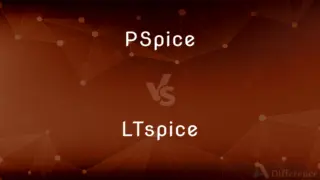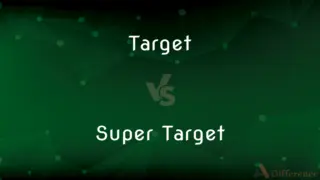Dinosaur vs. Reptile — What's the Difference?
By Tayyaba Rehman & Urooj Arif — Updated on March 21, 2024
Dinosaurs were a diverse group of reptiles that lived millions of years ago, characterized by various sizes and forms. Reptiles are a class of cold-blooded vertebrates that include snakes, lizards, crocodiles, and turtles, existing from ancient times.

Difference Between Dinosaur and Reptile
Table of Contents
ADVERTISEMENT
Key Differences
Dinosaurs are a specific, extinct subgroup of reptiles that thrived during the Mesozoic Era, which spanned from about 252 to 66 million years ago. Reptiles, on the other hand, are a broader class of animals (Class Reptilia) that have existed on Earth for hundreds of millions of years, from before the dinosaurs to the present day.
Dinosaurs' extinction at the end of the Cretaceous Period, about 66 million years ago, marked a significant event in Earth's history, leading to the rise of mammals as the dominant terrestrial animals. Meanwhile, reptiles have continued to adapt and evolve, resulting in the diverse range of species seen today.
In terms of lifestyle and adaptations, dinosaurs showcased a variety of forms, including herbivores, carnivores, and omnivores, with adaptations for running, swimming, and even flying. Modern reptiles exhibit a wide range of ecological roles as well, from aquatic turtles and marine iguanas to desert-dwelling snakes and tree-climbing lizards, demonstrating the adaptability and ecological diversity of the reptilian lineage.
Comparison Chart
Era
Mesozoic Era (252 to 66 million years ago).
Ancient times to present.
Modern Descendants
Birds are considered direct descendants.
Includes all current snakes, lizards, turtles, and crocodilians.
ADVERTISEMENT
Extinction
Became extinct 66 million years ago.
Still thriving with significant diversity.
Evolutionary Significance
Represent a specific evolutionary path within reptiles.
Include the ancestors of many modern animals, including dinosaurs and birds.
Skeletal Features
Unique hip and limb structures for an upright stance.
Varied, with many having a sprawling posture except for some like crocodiles.
Ecological Roles
Included herbivores, carnivores, and omnivores with various adaptations.
Exhibit a wide range of ecological roles across different habitats.
Compare with Definitions
Dinosaur
Varied diets and lifestyles, from herbivorous to carnivorous.
The Stegosaurus was a plant-eater with plates along its back for defense.
Reptile
Exhibit a sprawling posture, though some, like crocodiles, share similarities with dinosaurs.
Crocodiles have a semi-upright stance when running.
Dinosaur
Extinct reptiles of the Mesozoic Era, ranging from the giant Sauropods to the fierce T. rex.
The Sauropods were known for their long necks and tails.
Reptile
Many reptiles lay eggs, with some species showing parental care.
Some lizard species guard their eggs until they hatch.
Dinosaur
Dinosaurs laid eggs, some of which are fossilized and studied today.
Dinosaur egg fossils provide insights into their reproductive behavior.
Reptile
Adapted to a wide range of habitats, from deserts to oceans.
Marine iguanas are the only sea-going lizards, feeding on algae.
Dinosaur
Birds are the modern descendants of theropod dinosaurs.
Birds' anatomy shows many similarities with their dinosaur ancestors.
Reptile
Continue to evolve and diversify since ancient times.
The adaptability of snakes allows them to inhabit diverse environments worldwide.
Dinosaur
Characterized by an upright stance and diverse forms.
Velociraptors were small, agile dinosaurs with a fearsome reputation.
Reptile
Reptiles, as most commonly defined, are the animals in the class Reptilia , a paraphyletic grouping comprising all amniotes except synapsids (mammals and their extinct relatives) and Aves (birds). The class comprises turtles, crocodilians, snakes, amphisbaenians, lizards, tuatara, and their extinct relatives.
Dinosaur
Dinosaurs are a diverse group of reptiles of the clade Dinosauria. They first appeared during the Triassic period, between 243 and 233.23 million years ago, although the exact origin and timing of the evolution of dinosaurs is the subject of active research.
Reptile
A person regarded as contemptible or obsequious.
Dinosaur
Any of various extinct terrestrial reptiles of the orders Saurischia and Ornithischia that existed during the Mesozoic Era, including both carnivores and herbivores and often reaching a gigantic size.
Reptile
A reptile or amphibian.
Dinosaur
Any of various other large extinct reptiles, such as an ichthyosaur.
Reptile
(figuratively) A mean or grovelling person.
Dinosaur
A relic of the past
"living dinosaurs of the world of vegetation" (John Olmsted).
Reptile
Creeping; moving on the belly, or by means of small and short legs.
Dinosaur
One that is hopelessly outmoded or unwieldy
"The old, big-city teaching hospital is a dinosaur" (Peggy Breault).
Reptile
Grovelling; low; vulgar.
A reptile race or crew
Reptile vices
Dinosaur
(scientific) any of the animals belonging to the clade Dinosauria, especially those that existed during the Triassic, Jurassic and Cretaceous periods and are now extinct.
Reptile
Creeping; moving on the belly, or by means of small and short legs.
Dinosaur
(colloquial) any member of the clade Dinosauria other than birds.
Reptile
Hence: Groveling; low; vulgar; as, a reptile race or crew; reptile vices.
There is also a false, reptile prudence, the result not of caution, but of fear.
And dislodge their reptile soulsFrom the bodies and forms of men.
Dinosaur
(proscribed) Any extinct reptile, not necessarily belonging to Dinosauria, that existed between about 230 million and 65 million years ago.
Reptile
An animal that crawls, or moves on its belly, as snakes,, or by means of small, short legs, as lizards, and the like.
An inadvertent step may crush the snailThat crawls at evening in the public path;But he that has humanity, forewarned,Will tread aside, and let the reptile live.
Dinosaur
Something or someone that is very old or old-fashioned, or is not willing to change and adapt.
Reptile
One of the Reptilia, or one of the Amphibia.
Dinosaur
Anything no longer in common use or practice.
Reptile
A groveling or very mean person.
Dinosaur
One of the Dinosauria.
Dinosaur
Any of numerous extinct terrestrial reptiles of the Mesozoic era
Common Curiosities
Are all dinosaurs considered reptiles?
Yes, all dinosaurs are classified within the broader group of reptiles due to their shared characteristics and evolutionary history.
How do scientists differentiate dinosaur fossils from those of other reptiles?
Scientists use specific skeletal features, such as the structure of the hips and limbs, to distinguish dinosaur fossils from those of other reptiles.
Why are birds considered dinosaurs?
Birds are considered the direct descendants of theropod dinosaurs, sharing many skeletal and physiological traits that link them to this group.
Did dinosaurs and modern reptiles coexist?
Some groups of modern reptiles did coexist with dinosaurs, but the majority of reptile species we see today evolved after the dinosaurs' extinction.
What are some key differences between dinosaur and reptile reproduction?
While both dinosaurs and many modern reptiles lay eggs, differences in nesting behaviors, egg types, and parental care vary widely across species and time periods.
What led to the dinosaurs' extinction?
The most widely accepted theory is that a massive asteroid impact, combined with volcanic activity and climate change, led to the dinosaurs' extinction about 66 million years ago.
What adaptations allowed dinosaurs to dominate the Mesozoic Era?
Dinosaurs had a variety of adaptations, including diverse feeding strategies, efficient locomotion, different body sizes, and reproductive strategies, which allowed them to dominate various ecosystems during the Mesozoic Era.
How do the scales of modern reptiles compare to dinosaur skin?
Modern reptiles have scales made of keratin, while dinosaur skin impressions suggest they also had scales, though the texture and composition may have varied among species. Some dinosaurs also had feathers, similar to modern birds.
What role do reptiles play in modern ecosystems compared to dinosaurs in the past?
Reptiles today play diverse roles in ecosystems as predators, prey, and ecosystem engineers, similar to dinosaurs' roles in the past. However, the scale and diversity of dinosaurs' roles were more pronounced due to their dominance in terrestrial ecosystems during the Mesozoic Era.
How has our understanding of the link between dinosaurs and reptiles changed over time?
Advances in paleontology, including the discovery of feathered dinosaur fossils, have strengthened the connection between birds (a subgroup of reptiles) and dinosaurs, reshaping our understanding of evolutionary relationships.
How do modern reptiles contribute to their ecosystems?
Modern reptiles play crucial roles in their ecosystems as predators and prey, helping to maintain ecological balance through their diverse diets and behaviors.
Are there any reptiles today that closely resemble dinosaurs?
While no modern reptiles are direct replicas of dinosaurs, crocodilians share several anatomical features with them, and birds are considered their closest living relatives.
Share Your Discovery

Previous Comparison
Project vs. Seminar
Next Comparison
Advance vs. ProficientAuthor Spotlight
Written by
Tayyaba RehmanTayyaba Rehman is a distinguished writer, currently serving as a primary contributor to askdifference.com. As a researcher in semantics and etymology, Tayyaba's passion for the complexity of languages and their distinctions has found a perfect home on the platform. Tayyaba delves into the intricacies of language, distinguishing between commonly confused words and phrases, thereby providing clarity for readers worldwide.
Co-written by
Urooj ArifUrooj is a skilled content writer at Ask Difference, known for her exceptional ability to simplify complex topics into engaging and informative content. With a passion for research and a flair for clear, concise writing, she consistently delivers articles that resonate with our diverse audience.














































